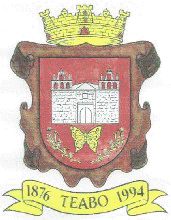- Teabo
Infobox City
image_
official_name = Teabo
other_name =
native_name =
nickname =
settlement_type = Village
motto =“Ahí donde están los ciruelos”
subdivision_type = Country
subdivision_name = MEX
subdivision_type1 = State
subdivision_name1 =Yucatán
subdivision_type2 =
subdivision_name2 =
subdivision_type3 =
subdivision_name3 =
subdivision_type4 =
subdivision_name4 =
government_footnotes =
government_type =
leader_title = Presidente Municipal
leader_name =
leader_title1 =
leader_name1 =
leader_title2 =
leader_name2 =
leader_title3 =
leader_name3 =
leader_title4 =
leader_name4 =
established_title = Yucatán independence from Spain
established_date = 1821
established_title1 = Acquires title of "village"
established_date1 = 1876
established_title3 =
established_date3 =
area_magnitude =
unit_pref =
area_footnotes =
area_total_km2 =
area_land_km2 =
area_water_km2 =
area_total_sq_mi =
area_land_sq_mi =101
area_water_sq_mi =
area_water_percent =
area_urban_km2 =
area_urban_sq_mi =
area_metro_km2 =
area_metro_sq_mi =
area_blank1_title =
area_blank1_km2 =
area_blank1_sq_mi =
population_as_of =2005
population_footnotes =
population_note =
population_total =5,602
population_density_km2 =
population_density_sq_mi =
population_metro =
population_density_metro_km2 =
population_density_metro_sq_mi =
population_urban =
population_density_urban_km2 =
population_density_urban_sq_mi =
population_blank1_title =Demonym
population_blank1 =Teabeños
population_density_blank1_km2 =
population_density_blank1_sq_mi =
timezone = CST
utc_offset = -6
timezone_DST =
utc_offset_DST =
latd=20 |latm=24 |lats=0 |latNS=N
longd=89 |longm=17 |longs=0 |longEW=W
coordinates_display = inline,title
coordinates_type = type:city_region:MX
elevation_footnotes =
elevation_m =
elevation_ft =
elevation_max_m = 7
elevation_max_ft =22
elevation_min_m =
elevation_min_ft =
postal_code_type = ZIP code
postal_code =77500
area_code =998
blank_name =
blank_info =
blank1_name =
blank1_info =
website =
footnotes =Teabo (pronounced|teh-ah-bo) is a small
town , and surrounding municipality of the same name, in the Mexican state ofYucatán .At the census of 2005, the town had a population of 5,602 people.
The Municipality of Teabo shares a boundary on the north with Mayapán-humayel, on the south with Tekax, on the east with Cantamayec-Tixméhuac and the west with Maní-Akil. It is home to indigenous Mayan people who continue to follow cultural traditions kept for hundreds of years.
Vestiges of an important Mayan cementery can be found in Teabo. Also, Teabo had two sacred buildings: The Parish and Ex-convent of San Pedro y San Pablo built in the XVII century and the Indian's Chapel that shows the date of 1617.
History
Regarding the foundation of Teabo and the municipality of the same name, the exact dates are not known. During pre-Hispanic times it belonged to the chieftainship of Tutul Xiú. After its conquest it remained under the control of various Spaniards, first recorded in 1753. The evolution of the population begins in 1821, when Yucatan declared its independence of the Spanish crown. In 1876, Teabo acquired the title of "Villa," or village. By means of published Decree #144, Teabo changed status from village to town.
Celebrations, Dances and Traditions
Popular celebrations
From April 28th to May 3rd- in honor of Santa Cruz; on July 27th, in honor to San Pedro and San Pablo; and from the 8th to the 12th of December in honor of the Virgin of Guadalupe, employer of the population.
Traditions and Customs
For the Festival of the Saints, families build altars in their houses and food is offered to the deceased; typically consisting of traditional Mucbil chicken, accompanied by a cornflour drink, and chocolate beaten with water. Regional celebrations always include a dance called jarana, and large competitions are held by participants.
Typical clothing
By custom the women use simple Huipil, with embroiderings that emphasize the squared cut of the neck and the edge of the dress, is placed on Fustán that is an average subject curly bottom to the waist with earthen jar of the same fabric; they wear sandals, and to protect itself of the sun they cover themselves with rebozo.
The farmers mainly the old ones dress comfortable trousers crude blanket, t-shirt buttoned to the front, mandil of cotí and straw hat. For vaquerías and main celebrations the women engalanan themselves with the Terno, made with fine fabrics, embroiders and embroidered cross facts generally by hand o'clock. This one complements long gold chains, earrings, rosary of chorale or filigree and overflow of Santa Maria.
The men dress white trousers cuts Philippine fabric rectum fine, (the rich ones take in this article gold set of buttons), canvas shoes and hats of jipijapa, without lacking the traditional red handkerchief, called popularly scarf, indispensable when dancing some jaranas.
Crafts
The preparation of typical clothes, the embroidering by hand or to machine, urdido of hammocks with cotton threads and talabartería.
Gastronomy
Foods
They prepare with mass of corn meat of pig, chicken and deer accompanied with sharp sauces with chili peppers Havanan and max. The main ones are: kidney bean with pig, chaya with egg, stew of hen, stuffed cheese, salbutes, panuchos, pipian of deer, papadzules, longaniza, pibil cochinita, joroches, mucbil chickens, pimes and tamales.
Candies
One makes yucca with honey, pumpkin melada, sweet potato with the Coco, cocoyol in syrup, pumpkin nugget marzipan, marshmallow, round maize loaves, tejocotes in syrup and candy of ciricote.
Drinks
The traditional drinks are xtabentun, balché, drunk of anise, pozole with the Coco, tiger nut milk, cornflour drink of new maize and refreshments of fruits of the region.
References
* [http://www.e-local.gob.mx/work/templates/enciclo/yucatan/municipios/31075a.htm Link to Mexican government website] e-local: Mexico's local government portalSee also:
Municipalities of Yucatán .
*INEGI/SECTURExternal links
* [http://www.e-local.gob.mx/work/templates/enciclo/yucatan/municipios/31075a.htm Link to Mexican government website] e-local: Mexico's local government portal
Wikimedia Foundation. 2010.
